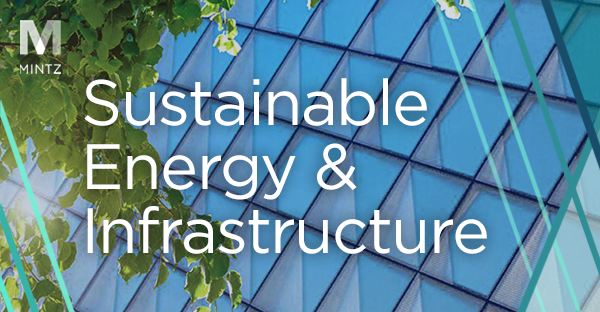September Energy, Sustainability, and Infrastructure Washington Update
Introduction
While August is typically a quiet month with Congress out of session, there were several significant developments in energy and environmental policy. The Department of Energy (DOE) rolled out plans for over $1 billion in funding to boost US research, production, and processing of critical minerals and rare earth materials. On Capitol Hill, lawmakers are backing proposals in the defense bill to strengthen the critical minerals supply chain and reduce reliance on imports. At the same time, the Trump administration is stepping up its shift away from renewables — canceling major solar and wind projects and tightening permitting rules. The Environmental Protection Agency (EPA) is also looking to undo the Greenhouse Gas Endangerment Finding, arguing that greenhouse gases don’t directly harm public health. And on the personnel front, there was a wave of activity before the Senate left town to confirm political appointments at EPA, DOE, Federal Energy Regulatory Commission (FERC), and the Nuclear Regulatory Commission.
Critical Minerals and Rare Earth Material Funding Opportunities
Following last month’s announcement that the Department of Defense (DOD) was making a direct investment in rare earth mining and processing through MP Materials, DOE announced, on August 13, 2025, notices of intent (NOI) to issue four notice of funding opportunities (NOFO) across different offices — totaling nearly $1 billion — to advance and scale mining, processing, and manufacturing technologies across key stages of the critical minerals and rare earth materials supply chains. The NOIs, preceding the actual release of the NOFOs, indicated that they would use authorities provided by the Energy Act of 2020 and the Infrastructure Investment and Jobs Act (IIJA) from the previous administration to move forward on the Trump administration’s objectives. Also in August, ARPA-E issued two additional NOFOs to secure the domestic critical mineral supply and strengthen magnet manufacturing. A full description of each pending and issued opportunity is provided below.
ML Strategies is well positioned to help you navigate critical mineral federal funding and other opportunities. Please don’t hesitate to reach out with questions.
- Battery Materials Processing and Battery Manufacturing and Recycling Grant Program
- The Office of Manufacturing and Energy Supply Chains (MESC) intends to issue a NOFO of up to $500 million to expand US critical mineral and materials processing and derivative battery manufacturing and recycling. The proposed funding opportunity supports demonstration and/or commercial facilities processing, recycling, or utilizing for manufacturing critical materials, which may include traditional battery minerals such as lithium, graphite, nickel, copper, aluminum, as well as other minerals that are contained within commercially available batteries, such as rare earth elements. An award requires a cost-share of at least 50% by the recipient.
- The Office of Manufacturing and Energy Supply Chains (MESC) intends to issue a NOFO of up to $500 million to expand US critical mineral and materials processing and derivative battery manufacturing and recycling. The proposed funding opportunity supports demonstration and/or commercial facilities processing, recycling, or utilizing for manufacturing critical materials, which may include traditional battery minerals such as lithium, graphite, nickel, copper, aluminum, as well as other minerals that are contained within commercially available batteries, such as rare earth elements. An award requires a cost-share of at least 50% by the recipient.
- Critical Minerals and Materials Accelerator
- The Advanced Materials and Manufacturing Technologies Office expects to release a NOFO of up to $50 million early this fall through the Critical Minerals and Materials (CMM) Accelerator program. The CMM Accelerator promotes technology maturation that can unlock capital investments and facilitate domestic commercialization. The proposed NOFO addresses several areas of interest, including processes in the rare earth magnet supply chain; processes to refine and alloy gallium, gallium nitride, germanium, and silicon carbide for use in semiconductors; cost-competitive technologies for direct lithium extraction and separation; and critical-material separation technologies that allow for the coproduction of useful products from byproducts and scrap.
- The Advanced Materials and Manufacturing Technologies Office expects to release a NOFO of up to $50 million early this fall through the Critical Minerals and Materials (CMM) Accelerator program. The CMM Accelerator promotes technology maturation that can unlock capital investments and facilitate domestic commercialization. The proposed NOFO addresses several areas of interest, including processes in the rare earth magnet supply chain; processes to refine and alloy gallium, gallium nitride, germanium, and silicon carbide for use in semiconductors; cost-competitive technologies for direct lithium extraction and separation; and critical-material separation technologies that allow for the coproduction of useful products from byproducts and scrap.
- Mines & Metals Capacity Expansion — Piloting Byproduct Critical Minerals and Materials Recovery at Domestic Industrial Facilities
- The Office of Fossil Energy and Carbon Management intends to issue a NOFO to support approximately $250 million of financial assistance for American industrial facilities that have the potential to produce valuable mineral byproducts from existing industrial processes. To derisk the technical uncertainty and financial risk for commercial deployment, many technologies must be piloted at an industrial scale in an industrial facility where material feedstocks can be processed. Areas of interest include mines and metal pilots in the coal-based industry and other industries.
- The Office of Fossil Energy and Carbon Management intends to issue a NOFO to support approximately $250 million of financial assistance for American industrial facilities that have the potential to produce valuable mineral byproducts from existing industrial processes. To derisk the technical uncertainty and financial risk for commercial deployment, many technologies must be piloted at an industrial scale in an industrial facility where material feedstocks can be processed. Areas of interest include mines and metal pilots in the coal-based industry and other industries.
- Rare Earth Elements Demonstration Facility
- MESC intends to issue a NOFO of up to $135 million for the design, construction, and operation of a Rare Earth Element Demonstration Facility. This facility will demonstrate the extraction, separation, and refinement of REEs from unconventional feedstock sources to produce high-purity rare earth metals. The facility must source feedstock derived from acid mine drainage, mine waste, e-waste, or other deleterious or harmful materials resulting from mining or industrial operations. An academic partner is required as a part of the project team and an award requires a cost-share of at least 50% by the recipient.
- MESC intends to issue a NOFO of up to $135 million for the design, construction, and operation of a Rare Earth Element Demonstration Facility. This facility will demonstrate the extraction, separation, and refinement of REEs from unconventional feedstock sources to produce high-purity rare earth metals. The facility must source feedstock derived from acid mine drainage, mine waste, e-waste, or other deleterious or harmful materials resulting from mining or industrial operations. An academic partner is required as a part of the project team and an award requires a cost-share of at least 50% by the recipient.
- MAGNITO Program
- ARPA-E released a NOFO making up to $20 million available for projects to employ artificial intelligence, machine learning, and high-throughput experimentation to develop novel magnetic materials with new chemistries and microstructures. The Magnetic Acceleration Generating New Innovations and Tactical Outcomes (MAGNITO) program anticipates successful applicants will comprise teams with various expertise, such as computational materials discovery, solid state chemistry, magnetism physics and computational methods, magnetic measurement and interpretation of data, and potential applications of ultra-powerful magnets. Concept papers are due September 24, 2025. The full application submission deadline has yet to be announced.
- ARPA-E released a NOFO making up to $20 million available for projects to employ artificial intelligence, machine learning, and high-throughput experimentation to develop novel magnetic materials with new chemistries and microstructures. The Magnetic Acceleration Generating New Innovations and Tactical Outcomes (MAGNITO) program anticipates successful applicants will comprise teams with various expertise, such as computational materials discovery, solid state chemistry, magnetism physics and computational methods, magnetic measurement and interpretation of data, and potential applications of ultra-powerful magnets. Concept papers are due September 24, 2025. The full application submission deadline has yet to be announced.
- ROCKS Program
- ARPA-E released a NOFO making up to $40 million available to develop fundamentally disruptive technologies to transform the ore deposit characterization process. The program will pursue technology that targets order-of-magnitude improvements in characterization with a primary focus on drilling, sensing, and analysis to shorten the timeline for feasibility assessments of REE and critical mineral deposits. Technologies of interest are grouped into three main categories: (1) drilling technology to increase penetration rates and core recovery; (2) sensing and analysis technologies to provide higher-resolution mineralogical and geochemical information, in situ or at a distance; and (3) other unique concepts that disrupt the current state of resource characterization for hard rock settings as well as REE-enriched clays, placer deposits, and seafloor resources. Concept papers are due September 25, 2025. The full application submission deadline has yet to be announced.
Critical Minerals and Rare Earths Within the FY26 National Defense Authorization Act (NDAA)
Separate from the DOE program activities on critical minerals and rare earth materials, both the House and Senate budget markups appear to provide several funding and programmatic amendments that could further support these priorities.
The Senate is scheduled to consider the FY26 National Defense Authorization Act (NDAA) on September 2, 2025, with several amendments focused on critical minerals under consideration. These proposals emphasize expanding domestic production and investment to strengthen the defense industrial base, securing supply chains, and requiring congressional reporting on critical mineral and rare earth element resources.
Notably, Senator Catherine Cortez Masto (D-Nev.) has introduced amendment SA 3392, which directs the president to use a portion of Defense Production Act funds to bolster US supply chains for critical minerals and their derivative products. The amendment calls for investments that expand domestic production in line with President Trump’s Executive Order 14241 and complement existing efforts under the Infrastructure Investment and Jobs Act. The measure defines critical minerals broadly to include those listed in the Energy Act of 2020, as well as uranium, copper, potash, gold, and others designated by the president. It also clarifies that derivative products range from semi-finished goods like semiconductor wafers, anodes, and cathodes, to final products such as electric vehicle batteries, smartphones, microprocessors, wind turbines, and advanced optical devices. In doing so, the amendment seeks to support the entire critical mineral supply chain, from raw material processing to advanced technology manufacturing.
On the House side, lawmakers are also prioritizing resilient critical mineral supply chains and expanded US refining and processing capacity. Interestingly, Rep. Jill Tokuda (D-Hawaii) has introduced an amendment highlighting Australia’s significant deposits of rare earths and other critical minerals, along with its mining and processing expertise. Her proposal directs the Secretary of Defense, in coordination with the Secretary of State, to report to the congressional defense committees by February 1, 2026 on potential approaches to expand the AUKUS partnership to include the development and guarantee of critical mineral supplies. The House is expected to consider the FY26 NDAA at a later date.
Once the two chambers vote on their respective versions of the NDAA, the chambers will enter a conference period to reconcile the two versions. The final version of the NDAA typically passes in December.
Agencies Ramp Up Targeting Renewables
- EPA Cancels Solar for All Program: EPA is planning to cancel the $7 billion Solar for All program, part of the $27 billion Greenhouse Gas Reduction Fund, which funds solar projects in low-income communities across the country.
- Interior Mandates Considering a Proposed Project’s Energy Density When Issuing a Permit: The Department of the Interior issued a Secretary’s Order mandating that the agency “permit only energy projects that are the most appropriate use of the federal land and resources.” The order takes direct aim at wind and solar projects, arguing that they take up “disproportionate” amounts of federal land compared to nuclear, gas, and coal projects with similar generation capacity.
- BOEM Rescinds Offshore Renewable Energy Leasing Schedule: The Bureau of Ocean Energy Management (BOEM) intends to publish a direct final rule to rescind a section of the department’s regulations that calls for publishing a schedule every two years of anticipated offshore renewable energy lease sales. The move comes after BOEM also formally rescinded all areas in the US Outer Continental Shelf for offshore wind development.
- Interior Cancels Lava Ridge Wind Project: Interior Secretary Burgum reversed the Biden administration’s approval of the Lava Ridge Wind Project, a wind facility in southern Idaho, after “crucial legal deficiencies in the issuance of the approval” were discovered.
- New IRS IRA Tax Credit Guidance: The IRS recently released new guidance on compliance for the Inflation Reduction Act tax credit for Sections 48E and 45Y, restricting qualification with a “Physical Work Test” and Continuity Requirements under the accelerated termination schedule set by the OBBB passed in July. Our Mintz colleague Gregg Benson has more to say on this here.
EPA Releases Proposal to Rescind Endangerment Finding
On July 29, 2025, EPA announced a proposed rule to rescind all greenhouse gas (GHG) emission standards for light-duty, medium-duty, and heavy-duty vehicles and engines under Clean Air Act (CAA) Section 202(a).
EPA proposes that CAA Section 202(a) does not authorize EPA to prescribe emission standards because “in order to be regulated, pollution must endanger public health and welfare by its presence in the ambient air.” EPA argues that GHGs do not endanger public health or welfare through local or regional exposure and thus impact public health and welfare “only indirectly,” meaning EPA does not have authority to regulate, since doing so places “effectively no constraint on EPA’s powers” and that “the proposal is not clear about exactly how much endangerment would qualify a pollutant for regulation.” EPA also argues that “no requisite technology for vehicle and engine emission control can even address the global climate change concerns identified in the findings without risking greater harms to public health and welfare.”
In its argument, EPA also suggests that “[w]ith respect to projected increases in GHG concentrations and global temperatures, the projections relied upon in the Endangerment Finding appear unduly pessimistic.” Among other references, EPA cites a report released on July 29, 2025 by DOE that claims the impact of GHGs on climate is not as significant as previously believed. This DOE report is currently undergoing litigation as Chris Frey, who led EPA’s Office of Research and Development during the Biden administration, filed a “request for correction” with DOE, citing “legal and procedural irregularities” in how the report’s authors were chosen and in the way they went about compiling and disseminating the assessment in conflict with the Federal Advisory Committee Act.
Nominations Updates
- The Senate confirmed Paige Hallen Hanson to serve as EPA’s Chief Financial Officer and Aaron Szabo to serve as Assistant Administrator of EPA’s Office of Air and Radiation.
- The Senate Energy and Natural Resources Committee advanced the nominations of Audrey Robertsonfor Assistant Secretary for Energy Efficiency and Renewable Energy (EERE) at DOE and Timothy John Walsh for Assistant Secretary for Environmental Management at DOE.
- President Trump is reportedly looking to tap Democratic FERC Commissioner and Biden-era appointee David Rosner to become FERC chair.
- President Trump nominated Ho Nieh to serve on the Nuclear Regulatory Commission (NRC) for the remainder of former Democratic Chair Christopher Hanson’s term. The announcement follows the Senate reconfirming Trump-appointed nominee David Wright to be NRC chair. Meanwhile, Republican Commissioner Annie Caputo resigned from the agency — the second abrupt departure in two months.

Energy & Sustainability Washington Update — August 2025
August 1, 2025| Article

The One Big Beautiful Bill Act Signed into Law: Tax Implications at a Glance
July 10, 2025| Alert




